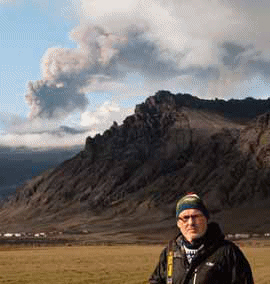SEJournal Online is the digital news magazine of the Society of Environmental Journalists. Learn more about SEJournal Online, including submission, subscription and advertising information.
By GUDMUNDUR PÁLL ÓLAFSSON
 |
|
The eruption of Iceland's Eyjafjallajökull volcano in April 2010. Photo © Gudmundur Páll Ólafsson.
|
Surprise may be the perfect word to describe the volcanic eruption of the stratovolcano Eyjafjallajökull in Iceland. The tongue twister (for outsiders) Eyja-fjalla-jökull, which means island-mountains-glacier, is probably one of the oldest live volcanoes in Iceland, but certainly not among the most active ones.
For most people, Eyjafjallajökull was simply a beautiful glacial cone rising 1600 meters above sea level, praised in romantic poetry for its grandeur. It had erupted three times after the settlement of Iceland — in 920, 1612, and 1821. All those eruptions were small in the geohistory of Iceland, as is the present one, which has caused so much chaos across Europe, in trans-Atlantic flights, and numerous cancellations of air transport between Asia, Africa and Europe.
Icelandic meteorologists, geologists, and geophysicists have an extensive alert system. Yet this eruption came as a total surprise when, on April 14, a 1 kilometer-long fissure gaped and immediately melted the 250 meter-thick ice-filled crater, producing tremendous explosions.
Prior to this event, there had been three months of seismic unrest during which magma rose slowly and surfaced on March 20 when a small fissure opened on the nearby Fimmvörðuháls. It was a dwarf-like outbreak considered a "tourist-eruption." Now we understand that the activity shifted a few kilometers west to the very crater of Eyjafjallajökull.
The present eruption changed everything. What was not expected was realized; a minor, local eruption became a global economic problem, and the shy volcano overnight became the most famous volcano in Iceland.
Dr. Haraldur Sigurđsson, an eminent professor emeritus of volcanology, puts the explosion in perspective: "What Eyjafjallajökull has done above all is to force upon us a visceral awareness of our interconnected world — woven together by the crisscrossing of airline routes. The impact of the eruption is an earthsystems science experiment in progress. It dramatically shows the links of many of the components of the earth, with impacts on the ocean, atmosphere, climate and biota — and on the economy."
How can such a relatively small eruption have such a tremendous impact? Although not fully understood yet, it has to do with the nature of the eruption, and the sophisticated technical world we live in.
In most Icelandic volcanoes, the magma is basaltic. The magma of Eyjafjallajökull, however, is andesite, and its gas content may play a leading role in how it behaves. The gas pressure in the viscous magma forced great gas bubbles to the surface and produced huge explosions, and the lava exploded into extremely fine ash when the boiling andesite magma met meltwater in the crater. The flour-like dust became airborne and stayed aloft longer than usual with far reaching effects on aviation, small and large businesses, not least of which were tourism and travel companies, affecting millions of people.
 |
|
Author and photographer Gudmundur Páll Ólafsson reporting on the 2010 Eyjafjallajökull volcano eruption in Iceland. Photo © Gudmundur Páll Ólafsson.
|
Most Icelanders are nonchalant about this eruption, although we think it an exciting and spectacular event. We are used to them, as there is a volcanic outbreak every ten years or so. Here, air and road travel has been affected by the eruption, but there is no direct threat from the volcano and no one has died or been injured. Only a few farms directly under the volcano have been damaged by the ash fall, and now that the volcanic activity has changed into a lava flow from the crater, volunteers are going to the region by the hundreds to help farmers to clear the ash off the farmland.
In the last few years, the active volcanic zone of Iceland has shown considerable seismic unrest. This unrest may be caused by the melting of the glaciers and gradual rise of the landmass, as is thought to have been the case when the ice cap of the last Ice Age melted. Then tremendous volcanic activity broke out. We may therefore expect intense eruptions in times to come. That is not the same as saying that the next eruption in Iceland will have an impact on aviation or climate around the world. Volcanoes are unpredictable monsters. We only know that there are larger and more powerful volcanoes in our explosive landscape than Eyjafjallajökull — some of them buried under deep layers of ice, others open to the sky — and some of these or none may burst open in the near future.
While the Eyjafjallajökull surprised us all, the fact that volcanism in Iceland can have a global effect should surprise nobody. In 1783 a 25 kilometer-long fissure named Lakagígar (The Craters of Mt. Laki) erupted and produced a sulfuric aerosol mass that affected temperatures around the globe for three years.
SEJ member Gudmundur Páll Ólafsson is a writer, naturalist and nature photographer who lives in Stykkishólmur, about 230km from the volcano. He can be reached at gpo4444@gmail.com
* From SEJ's quarterly newsletter SEJournal, Summer 2010 issue












 Advertisement
Advertisement 



